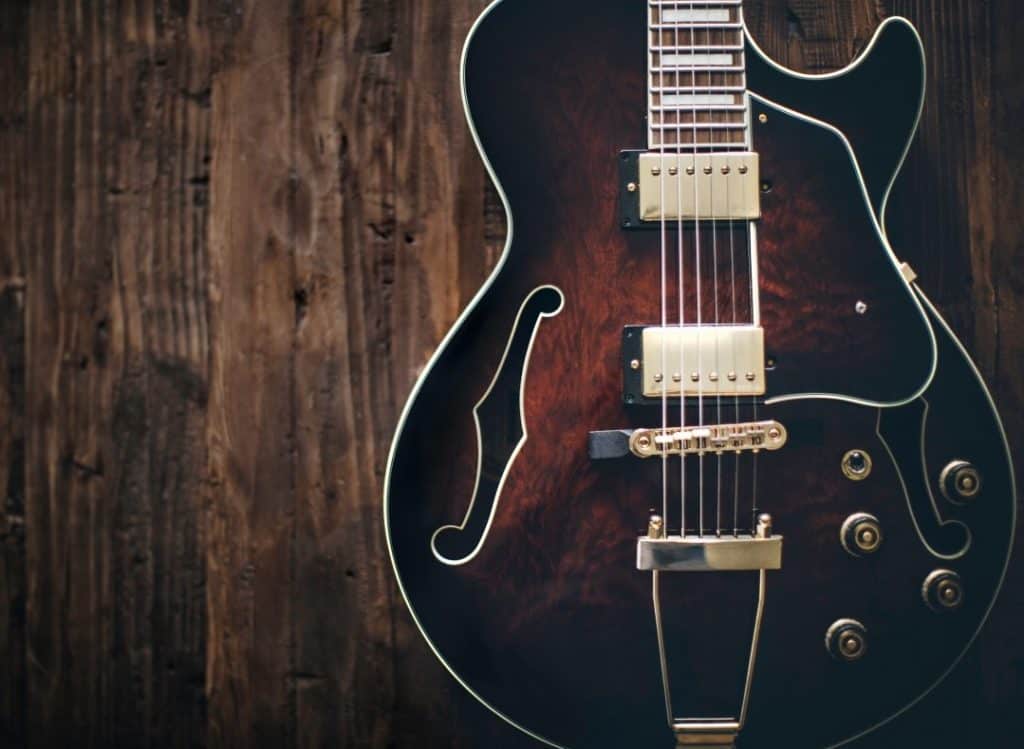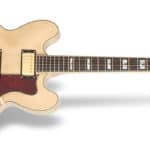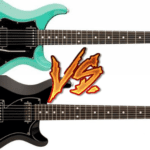In the world of hollow-body guitars, tailpieces are a serious thing.
Team trapeze will say that the true tone of a guitar can only be achieved when installing the proper kind of bridge.
On the other side, team stop tail will remind everyone that we are in the 21st century.
My job here is to mediate on this matter and lay out the facts that may lean you either way.
For the most anxious readers, if you want a short answer about the differences between a trapeze tailpiece and a stop tailpiece, here it is:
The main difference between a trapeze and a stop tailpiece is their design and its effects on tone and performance. Trapeze tailpieces make guitars sound “more hollow”, but have tuning issues and reduced sustain. Stop tailpieces give the guitar a more solid-body sound, but don’t have these issues.
For those who want to stay for a bit longer, in this article I will discuss the pros and cons of both these designs.
After that, we will talk if the differences are actually that noticeable and if swapping the tailpiece on your guitar is worth it.
Finally, I will give you my final thoughts on this whole deal.
Are you ready to get started?
Let’s go!
The case for a trapeze tailpiece

You might hate me for starting with this one, but for many players, a big reason for choosing a trapeze tailpiece will be its aesthetics.
Apart from that, players report mainly 2 features, the second one being rather hard to explain or quantify:
- A trapeze tailpiece allows you to manipulate the strings behind the bridge
- It makes hollow-body guitars sound “more hollow”
And this sounding more hollow thing is rather hard to explain.
Although subtle, guitars with this kind of tailpiece are reported to sound a bit more “airy” and looser.
If you are a fan of vintage specs and sounds, perhaps this is your tailpiece.
There are, however, some drawbacks to this option, and I will tackle them in the next section.
The case for a stop tailpiece
Going for the stop tail alternative, I think is more about running away from a trapeze than chasing the marvels of this other kind of tailpiece.
You see, in no particular order, here are some of the main drawbacks of a trapeze tailpiece:
- Reduced sustain
- Tuning problems with low gauge strings
- The guitar goes out of tune when a string breaks
- Increased sensitivity to feedback
A stop tail fights all of these issues, but at a cost that many players are willing to pay.
This is a slightly different tone, leaning more towards the one of a solid-body instrument.
Of course, this detailed tonal debate is just for us coffee guitar talkers that like to consider every single detail of the instrument at great length.
In a live show, no audience member will ever even notice any of these differences apart from the aesthetic ones.
Differences between the two
To name just the more obvious difference, let me just point out the dissimilar design of both these parts.
The trapeze is a tailpiece that counterbalances the tension of the strings, and when these are tightened floats above the top of the guitar.
The stop tail is fixed in place, and as its name implies, works by acting as a fixed anchor point for the strings.
And to recap, these different approaches on how to hold the strings achieve slightly different tones, the trapeze being a more vintage, hollow, one, and the stop tail getting more into the solid-body territory.
Is it worth it to convert your guitar from one to the other?
Unless you have a strong passion for one or the other kind of tailpiece, I would argue that modifying your guitar is not worth it.
The difference in tone you could achieve is probably not enough to offset the costs and labor required to do this kind of mod.
Not that it’s something extremely esoteric, but I’m a bit lazy about working on my guitars.
If you are a tweaker by nature, this might be a different story for you.
However, I can think of the shift from a trapeze to a stop tail being way more common because of the drawbacks mentioned above that this design has.
But it’s all a matter of taste, after all. You should do whatever your heart dictates it’s better.
Conclusions
My opinion on this topic is that you are probably better of not worrying that much about what holds your strings in place.
Just keep whatever tailpiece your guitar actually has, unless it’s hindering your playing or the quality of life of your live performances.
Again, the most harmful of these 2 is probably the trapeze, however, you might be in love with its tone and willing to stay in that toxic relationship just for its sound.
And that’s something that would make me very proud of you, as a GearAficionado.

Hello there, my name is Ramiro and I’ve been playing guitar for almost 20 years. I’m obsessed with everything gear-related and I thought it might be worth sharing it. From guitars, pedals, amps, and synths to studio gear and production tips, I hope you find what I post here useful, and I’ll try my best to keep it entertaining also.





